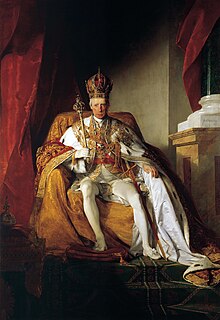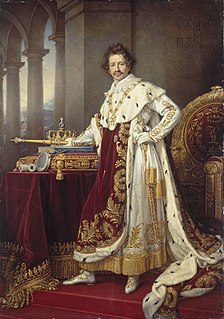
Francis II was the last Holy Roman Emperor from 1792 to 1806 and, as Francis I, the first Emperor of Austria from 1804 to 1835. He assumed the title of Emperor of Austria in response to the coronation of Napoleon as Emperor of the French. Soon after Napoleon created the Confederation of the Rhine, Francis abdicated as Holy Roman Emperor. He was King of Hungary, Croatia and Bohemia. He also served as the first president of the German Confederation following its establishment in 1815.

Oscar I was King of Sweden and Norway from 8 March 1844 until his death. He was the second monarch of the House of Bernadotte.

Ferdinand VII was the King of Spain during the early- to mid-19th century. He reigned over the Spanish Kingdom in 1808 and again from 1813 to his death in 1833. He was known to his supporters as el Deseado and to his detractors as el Rey Felón.

William I or Wilhelm I of the House of Hohenzollern was King of Prussia from 2 January 1861 and the first German Emperor from 18 January 1871 to his death. William was the first head of state of a united Germany, and was also de facto head of state of Prussia from 1858 to 1861, serving as regent for his brother, Frederick William IV.

Ferdinand I was the Emperor of Austria from March 1835 until his abdication in December 1848. As ruler of Austria, he was also President of the German Confederation, King of Hungary, Croatia and Bohemia, King of Lombardy–Venetia and holder of many other lesser titles. Due to his rocky, passive but well-intentioned character, he gained the sobriquet The Benign or The Benevolent.

Ludwig I or Louis I was king of Bavaria from 1825 until the 1848 revolutions in the German states.

Frederick William III was king of Prussia from 1797 to 1840. He ruled Prussia during the difficult times of the Napoleonic Wars. Steering a careful course between France and her enemies, after a major military defeat in 1806, he was humiliated by Napoleon, and Prussia was stripped of recent gains and forced to pay substantial financial penalties. The king reluctantly joined the coalition against Napoleon in the Befreiungskriege. Following Napoleon's defeat, he took part in the Congress of Vienna, which assembled to settle the political questions arising from the new, post-Napoleonic order in Europe. His primary interests were internal, the reform of Prussia's Protestant churches. He was determined to unify the Protestant churches to homogenize their liturgy, organization, and architecture. The long-term goal was to have fully centralized royal control of all the Protestant churches in the Prussian Union of Churches. The king was said to be extremely shy and indecisive. His wife Queen Louise (1776–1810) was his most important political advisor. She led a mighty group that included Baron vom Stein, Prince von Hardenberg, von Scharnhorst, and Count Gneisenau. They set about reforming Prussia's administration, churches, finance, and military.

Archduke Franz Karl Joseph of Austria was a member of the House of Habsburg-Lorraine. He was the father of two emperors: Franz Joseph I of Austria and Maximilian I of Mexico. Through his third son Karl Ludwig, he was the grandfather of Archduke Franz Ferdinand of Austria – whose assassination sparked the hostilities that led to the outbreak of World War I – and the great-grandfather of the last Habsburg emperor Karl I.

George was a king of Saxony and member of the House of Wettin.

DomFerdinand II was a German prince of the House of Saxe-Coburg and Gotha-Koháry, and King of Portugal jure uxoris as the husband of Queen Maria II, from the birth of their first son in 1837 to her death in 1853.

Charles was King of Württemberg, from 25 June 1864 until his death in 1891.

Grand Duke Konstantin Nikolayevich (1827-1892) was the second son of Nikolai I and his wife Charlotte of Prussia. Konstantin married Alexandra of Saxe-Altenburg in 1848 and they had six children.

Grand Duke Michael Nikolaevich of Russia was the fourth son and seventh child of Tsar Nicholas I of Russia and Charlotte of Prussia. He was the first owner of the New Michael Palace on the Palace Quay in Saint Petersburg.

Prince Frederick Henry Albert of Prussia was the fifth son and youngest child of King Frederick William III of Prussia and Louise of Mecklenburg-Strelitz. His parents had fled to East Prussia after the occupation of Berlin by Napoleon, and Albert was born in Königsberg. Two of Albert's elder brothers were Frederick William IV, King of Prussia from 1840 till 1861, and William I, King of Prussia from 1861 to 1888 and German Emperor from 1871 until 1888.

Karl Philipp, Fürst zu Schwarzenberg was an Austrian field marshal.

Joseph Georg Friedrich Ernst Karl, Duke of Saxe-Altenburg, was a duke of Saxe-Altenburg.

Prince Karl Anton of Hohenzollern-Sigmaringen was head of the Princely House of Hohenzollern-Sigmaringen, Hohenzollern from 1869 and Prime Minister of Prussia which made him the only Prussian Prince to hold that post. He was the son of Karl, Prince of Hohenzollern-Sigmaringen, who abdicated in favour of his son on 27 August 1848, and his first wife Marie Antoinette Murat, niece of Joachim Murat.

Prince Ferdinand of Saxe-Coburg and Gotha was a German prince of the House of Saxe-Coburg and Gotha and a general of cavalry in the Austrian Imperial and Royal Army during the Napoleonic Wars. Despite remaining a Lutheran, by marriage he established the Catholic branch of the family, which eventually gained the thrones of Portugal (1837) and Bulgaria (1887).

Constantin, Prince of Hohenzollern-Hechingen, was the last Prince of Hohenzollern-Hechingen. Constantine was the only child of Frederick, Prince of Hohenzollern-Hechingen and his wife, Princess Pauline of Courland, the daughter of the last Duke of Courland, Peter von Biron.

Prince Friedrich Wilhelm Ludwig of Prussia, known in English as Frederick, was a Prussian prince, general of the royal cavalry, and division commander.






























